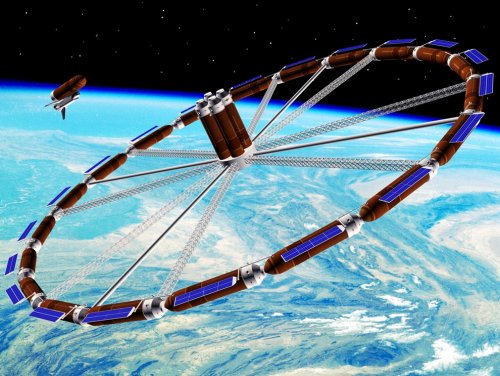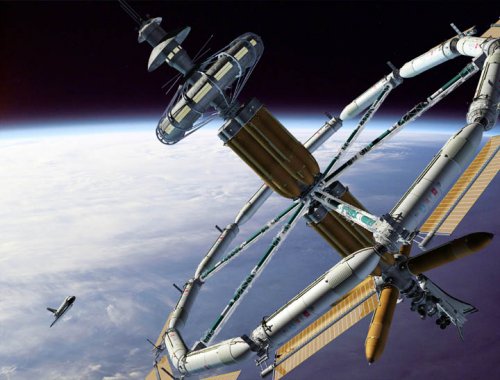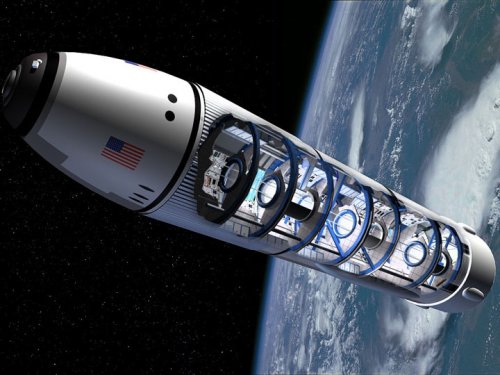Has anybody any information concerning possible alternative uses for the Space Shuttle's External Tank? I know that there were some plans to use it as part of a space station project, but were there any other proposed uses for them?
You are using an out of date browser. It may not display this or other websites correctly.
You should upgrade or use an alternative browser.
You should upgrade or use an alternative browser.
Space Shuttle External Tanks
- Thread starter papacavy
- Start date
- Joined
- 26 September 2008
- Messages
- 1,960
- Reaction score
- 738
There have been a bunch over the years. You should look up Space Island One for one of the crazier proposals (hint: they wanted to build an international fleet of 10 space shuttles).
One of the big problems with using the ET as a space station was that the foam shed in orbit, so you would have a lot of debris around the space station. Another problem is that structure is cheap, but all the stuff you put inside it is expensive, so an ET doesn't get you very much savings, just a lot of volume to fill up.
There were some more sane ideas, such as attaching a cargo pod at the rear of the ET and using the ET primarily as a strongback for this cargo pod, which could have 1-2 decks of pressurized space. Problems included the foam shedding, also the fact that this pod/cannister would be down near the shuttle engines and therefore face a lot of heat and noise and vibration.
One of the big problems with using the ET as a space station was that the foam shed in orbit, so you would have a lot of debris around the space station. Another problem is that structure is cheap, but all the stuff you put inside it is expensive, so an ET doesn't get you very much savings, just a lot of volume to fill up.
There were some more sane ideas, such as attaching a cargo pod at the rear of the ET and using the ET primarily as a strongback for this cargo pod, which could have 1-2 decks of pressurized space. Problems included the foam shedding, also the fact that this pod/cannister would be down near the shuttle engines and therefore face a lot of heat and noise and vibration.
- Joined
- 13 August 2007
- Messages
- 8,363
- Reaction score
- 10,733
add Fuel Tank with Fuelcell, Solar panels and Docking system.
Shuttle dock on it use Solar panels during its mission like Spacelab.
Shuttle pump Ballast water in Fuelcell and with Electrolysis who separate
Water in oxygen and Hydrogene for Space Tugs
another use was ET as Hull for Space Telescope
bigger Hubble or Gamma's Ray telescope
also were idea
to use free space between LOX and LH2 Tanks for Experiments
how need only some minute zero gravity
some links on the crazier ET Proposal
http://www.orbit6.com/et/
http://www.astronautix.com/craft/stsation.htm
http://www.permanent.com/p-extank.htm
http://spacestudiesinstitute.wordpress.com/space-art/the-don-davis-high-frontier-artshow/
Shuttle dock on it use Solar panels during its mission like Spacelab.
Shuttle pump Ballast water in Fuelcell and with Electrolysis who separate
Water in oxygen and Hydrogene for Space Tugs
another use was ET as Hull for Space Telescope
bigger Hubble or Gamma's Ray telescope
also were idea
to use free space between LOX and LH2 Tanks for Experiments
how need only some minute zero gravity
some links on the crazier ET Proposal
http://www.orbit6.com/et/
http://www.astronautix.com/craft/stsation.htm
http://www.permanent.com/p-extank.htm
http://spacestudiesinstitute.wordpress.com/space-art/the-don-davis-high-frontier-artshow/
FutureSpaceTourist
ACCESS: Top Secret
- Joined
- 10 March 2010
- Messages
- 590
- Reaction score
- 34
A couple of Space Island Group images attached, more on their website.
Attachments
- Joined
- 26 September 2008
- Messages
- 1,960
- Reaction score
- 738
Over a decade ago I acquired a VHS tape by them showing their plans. Really amazingly detached from reality. They proposed building more space shuttles and launching them from around the world.
I should find that tape. Or maybe they have the video on their website.
I should find that tape. Or maybe they have the video on their website.
FutureSpaceTourist
ACCESS: Top Secret
- Joined
- 10 March 2010
- Messages
- 590
- Reaction score
- 34
blackstar said:Really amazingly detached from reality. [...] Or maybe they have the video on their website.
They have a number of videos at http://www.spaceislandgroup.com/video-gallery.html. I've just been viewing their Space Island Group Project video on that page from October 2002. It includes the following statements:
- "we will create a fleet of dramatically improved, safer and lower cost shuttles"
- "our workforce will be several hundred and our first flight will take place in just four years"
- "[existing aerospace contractors processes] can't mass produce the dozens of shuttles and hundreds of ETs this project will need"
Amazingly detached from reality is a bit of an under-statement! Not seen much mention yet of how this would be funded ...
Nik
ACCESS: Top Secret
- Joined
- 15 July 2009
- Messages
- 1,261
- Reaction score
- 1,052
IIRC, there were still-born plans for Shuttles to 'burn the tank dry' and carry it into orbit.
Sundry snags included the weight overheads, the severe restrictions on payloads --Flown Shuttles ran rather heavier than hoped-- and that pesky, crumbly foam. Then they'd need multiple space-walks to clad the exterior in reflective 'bumper' layers which would have to be hauled to orbit. Then there was the weight of space-rated hatches and connecting tunnels, which would have to be hauled to orbit and retrofitted due to their materials' incompatibility with cryo-stuff...
Oh, and the tankage was full of baffles which would need to be removed without leaving sharps...
Given a *real* space station and routine spacewalks, all of this would just take work. Given the limited shuttle fleet and their modest endurance, plus the 'too-little, too-late' ISS build, it was a non-runner...
IMHO, had Skylab survived to form the nucleus of a space station, the different outlook might have changed things. Perhaps, but probably not. IIRC, Skylab was seen as 'old tech', 'Apollo stuff', unfit for the bold, new Shuttle era. Of course, having painted themselves into a corner, NASA discovered that the Shuttle just could not deliver on time or on budget...





Sundry snags included the weight overheads, the severe restrictions on payloads --Flown Shuttles ran rather heavier than hoped-- and that pesky, crumbly foam. Then they'd need multiple space-walks to clad the exterior in reflective 'bumper' layers which would have to be hauled to orbit. Then there was the weight of space-rated hatches and connecting tunnels, which would have to be hauled to orbit and retrofitted due to their materials' incompatibility with cryo-stuff...
Oh, and the tankage was full of baffles which would need to be removed without leaving sharps...
Given a *real* space station and routine spacewalks, all of this would just take work. Given the limited shuttle fleet and their modest endurance, plus the 'too-little, too-late' ISS build, it was a non-runner...
IMHO, had Skylab survived to form the nucleus of a space station, the different outlook might have changed things. Perhaps, but probably not. IIRC, Skylab was seen as 'old tech', 'Apollo stuff', unfit for the bold, new Shuttle era. Of course, having painted themselves into a corner, NASA discovered that the Shuttle just could not deliver on time or on budget...
FutureSpaceTourist said:
- "we will create a fleet of dramatically improved, safer and lower cost shuttles"
Sure, Hugo Drax promised that, and claimed to have built a fleet of five private shuttles, but where'd they go? Nobody's heard a word about 'em in thirty years.
- Joined
- 26 September 2008
- Messages
- 1,960
- Reaction score
- 738
Nik said:IIRC, there were still-born plans for Shuttles to 'burn the tank dry' and carry it into orbit.
Sundry snags included the weight overheads, the severe restrictions on payloads --Flown Shuttles ran rather heavier than hoped-- and that pesky, crumbly foam. Then they'd need multiple space-walks to clad the exterior in reflective 'bumper' layers which would have to be hauled to orbit. Then there was the weight of space-rated hatches and connecting tunnels, which would have to be hauled to orbit and retrofitted due to their materials' incompatibility with cryo-stuff...
Oh, and the tankage was full of baffles which would need to be removed without leaving sharps...
It was such a great idea at first blush, but it quickly gets nasty when you start looking at the details. Somebody told me long ago--way before Columbia--that somebody had done a test of the tank foam in vacuum and it just starts popping off because of internal pressure. Not sure how bad this would be compared to what has been seen late in shuttle ascent. But even a moderate amount of popcorning would leave your space station surrounded by a foam debris cloud.
Many more years ago I was at a talk with NASA's space station program manager where somebody asked him about this. He had a simple answer, which is that structure is cheap. They didn't really need more structure, and an ET wasn't going to save any money (in fact, as you note, it could do the opposite). The expensive stuff on a station is all the electronics, power, and stuff that they stick inside. A big empty aluminum can doesn't solve any of those problems.
blackstar said:But even a moderate amount of popcorning would leave your space station surrounded by a foam debris cloud.
Not for very long, though. Aerodynamic drag would do wonders to sweep such debris safely away and de-orbit it.
As for structure being cheap... I'd hesitate to call *anything* that costs ten grand a pound "cheap."
FutureSpaceTourist
ACCESS: Top Secret
- Joined
- 10 March 2010
- Messages
- 590
- Reaction score
- 34
Nik said:Only they didn't happen, either...
Some in Congress are still trying to make it happen, although I'm not sure they'll get it through appropriations.
FutureSpaceTourist
ACCESS: Top Secret
- Joined
- 10 March 2010
- Messages
- 590
- Reaction score
- 34
Well other than being a VTVL concept, I don't really see what their Crew Transport Vehicle has in common with the DC-X (and I assume they mean DC-Y rather than the subscale, non-orbital DC-X prototype?)
I read an article last year that Gene Meyers (front man for Space Island Group) was now pushing space-based solar power projects. Here's an article from July of 2009.
http://solarenergydirectory.com/blog/news/first-space-to-earth-solar-power-station-targeted-for-oct-2010
Lots of dreaming... and not much more than that.
http://solarenergydirectory.com/blog/news/first-space-to-earth-solar-power-station-targeted-for-oct-2010
Lots of dreaming... and not much more than that.
Nik said:IIRC, there were still-born plans for Shuttles to 'burn the tank dry' and carry it into orbit.
Sundry snags included the weight overheads, the severe restrictions on payloads --Flown Shuttles ran rather heavier than hoped-- and that pesky, crumbly foam. Then they'd need multiple space-walks to clad the exterior in reflective 'bumper' layers which would have to be hauled to orbit. Then there was the weight of space-rated hatches and connecting tunnels, which would have to be hauled to orbit and retrofitted due to their materials' incompatibility with cryo-stuff...
Oh, and the tankage was full of baffles which would need to be removed without leaving sharps...
Which brings up a good question concerning the viability of the AAP "Wet Workshop" approach. How much of a problem would it have truly been to outfit a S-IVB interior? Would this really have worked or not?
Nik
ACCESS: Top Secret
- Joined
- 15 July 2009
- Messages
- 1,261
- Reaction score
- 1,052
Given ample space-walk time, tanks tethered to a station with non-minimal crew could be retro-fitted.
Given the way the Apollo / Saturn systems were not 'derived' for heavy lifts, and the sad delay before the Shuttle delivered too little, too late, and the way the ISS' work is so tightly choreographed, well...
Given the way the Apollo / Saturn systems were not 'derived' for heavy lifts, and the sad delay before the Shuttle delivered too little, too late, and the way the ISS' work is so tightly choreographed, well...
OM
ACCESS: Top Secret
Nik said:Given the way the Apollo / Saturn systems were not 'derived' for heavy lifts...
...Not to be anal, but if the Saturn V wasn't for heavy lifts...well, you get the picture.
- Joined
- 26 September 2008
- Messages
- 1,960
- Reaction score
- 738
DaveJ576 said:Which brings up a good question concerning the viability of the AAP "Wet Workshop" approach. How much of a problem would it have truly been to outfit a S-IVB interior? Would this really have worked or not?
It would have been a problem. I imagine that it could have been made to work, but it would have been really difficult. Keep in mind as well that in the mid-1960s the US had only a few hours of spacewalk time. That's it. There was a lot that they didn't know, and didn't realize. It's entirely possible that if they had pursued the wet workshop design, they would have realized--perhaps too late--that they could not make it work. For example, what if they had put astronauts inside that tank and had them try and move pieces of equipment around only to discover that there were insufficient handholds and footrests? Or what if they had discovered that the baffles had sharp edges and punctured a suit?
It's always an interesting thought exercise to look back at things that were proposed in the 1960s and evaluate them in light of what we know today. For instance, none of the manned Mars landing concepts that have been proposed to date--and that includes ones proposed even a few years ago--would work. Zubrin's 1980s era Mars Direct concept? That would plow straight into the ground. It turns out that our current technology is insufficient for Mars landers even a little bit larger than the Mars Science Laboratory.
- Joined
- 13 August 2007
- Messages
- 8,363
- Reaction score
- 10,733
i found a paper about a ET Space station
"Space Shuttle External Tank Used as a Space Station Study Project Perun"
online on Wikisource
http://en.wikisource.org/wiki/Perun_1979

"Space Shuttle External Tank Used as a Space Station Study Project Perun"
online on Wikisource
http://en.wikisource.org/wiki/Perun_1979

- Joined
- 26 September 2008
- Messages
- 1,960
- Reaction score
- 738
Michel Van said:i found a paper about a ET Space station
"Space Shuttle External Tank Used as a Space Station Study Project Perun"
online on Wikisource
http://en.wikisource.org/wiki/Perun_1979
There was an issue of Space World in the mid-1980s that had a number of examples of this. There were some interesting concepts, but they fell apart when you got into the details.
There have been a bunch over the years. You should look up Space Island One for one of the crazier proposals (hint: they wanted to build an international fleet of 10 space shuttles).
One of the big problems with using the ET as a space station was that the foam shed in orbit, so you would have a lot of debris around the space station. Another problem is that structure is cheap, but all the stuff you put inside it is expensive, so an ET doesn't get you very much savings, just a lot of volume to fill up.
There were some more sane ideas, such as attaching a cargo pod at the rear of the ET and using the ET primarily as a strongback.
Yet such an inert External Tank/SLS core would still be less a threat to LEO than the Starship I imagine…it looked to be shedding a lot too…yet people act like foam can’t be covered or a propellant filled depot can’t burst.
Gene Meyers is still around.
There is no "imagining", it needs to be based on facts and data and not day dreams. Explain yourself. External Tank has a large beam in it.Yet such an inert External Tank/SLS core would still be less a threat to LEO than the Starship I imagine…
no. The concept is not the issue. It is your statement "an inert External Tank/SLS core would still be less a threat to LEO than the Starship I imagine", this claim needs data to back it up.Mark Holderman did work on the GEODE concept...I don't think he is a "daydreamer" and knows all the specs--ask him.
Also again, you need to add more to your posts. Who is Mark Holderman and what is the GEODE concept?
You get very little "likes" or comments to your posts because most people don't understand them.
Then again, maybe I shouldn't poke the dog and it will stay quiet.
- Joined
- 3 June 2006
- Messages
- 3,086
- Reaction score
- 3,900
Video:Hazegrayart said:Humpback Shuttle, External Tank Space Station
An undefined need for more payload bay volume inspired the thought that the lee side area above the payload bay (at entry angles of attack) could be used for an expanded bay. This resulted in what was called the “humpback” orbiter. The wind shield area was
faired into the higher moldline and whole faired into the vertical fin trailing edge. There was no change in the hypersonic aerodynamic characteristics at high angles of attack. However, there was no evaluation of the subsonic aerodynamic characteristics, but it is likely that there some degradation of directional stability.
STS External Tank Station
In 1980, NASA conducted a study on various concepts for an American manned space station, focusing on the 'wet workshop' approach. This concept involved using the large External Tank carried into orbit by each shuttle flight to create a spacious space station.
Although the idea was highly cost-effective and practical, NASA management ultimately did not pursue it seriously. The proposal was viewed as a tempting low-cost alternative to their own ambitious plans for a large modular space station.
Link:
Code:
https://youtu.be/0w4B0C_nBPg?si=CTVcMHCrBIpn4Vc8Similar threads
-
-
-
-
-
Candidate Space Shuttle Orbiters Wind Tunnel Studies 1969 NASA Langley Research
- Started by Hanse
- Replies: 2



